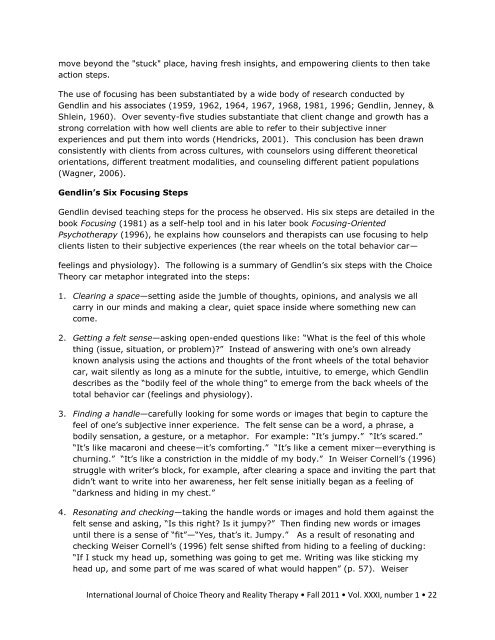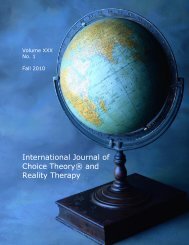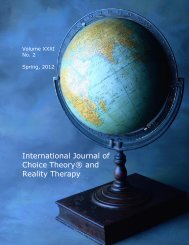International Journal of Choice Theory® and Reality ... - CTRTJournal
International Journal of Choice Theory® and Reality ... - CTRTJournal
International Journal of Choice Theory® and Reality ... - CTRTJournal
You also want an ePaper? Increase the reach of your titles
YUMPU automatically turns print PDFs into web optimized ePapers that Google loves.
move beyond the "stuck" place, having fresh insights, <strong>and</strong> empowering clients to then take<br />
action steps.<br />
The use <strong>of</strong> focusing has been substantiated by a wide body <strong>of</strong> research conducted by<br />
Gendlin <strong>and</strong> his associates (1959, 1962, 1964, 1967, 1968, 1981, 1996; Gendlin, Jenney, &<br />
Shlein, 1960). Over seventy-five studies substantiate that client change <strong>and</strong> growth has a<br />
strong correlation with how well clients are able to refer to their subjective inner<br />
experiences <strong>and</strong> put them into words (Hendricks, 2001). This conclusion has been drawn<br />
consistently with clients from across cultures, with counselors using different theoretical<br />
orientations, different treatment modalities, <strong>and</strong> counseling different patient populations<br />
(Wagner, 2006).<br />
Gendlin’s Six Focusing Steps<br />
Gendlin devised teaching steps for the process he observed. His six steps are detailed in the<br />
book Focusing (1981) as a self-help tool <strong>and</strong> in his later book Focusing-Oriented<br />
Psychotherapy (1996), he explains how counselors <strong>and</strong> therapists can use focusing to help<br />
clients listen to their subjective experiences (the rear wheels on the total behavior car—<br />
feelings <strong>and</strong> physiology). The following is a summary <strong>of</strong> Gendlin‘s six steps with the <strong>Choice</strong><br />
Theory car metaphor integrated into the steps:<br />
1. Clearing a space—setting aside the jumble <strong>of</strong> thoughts, opinions, <strong>and</strong> analysis we all<br />
carry in our minds <strong>and</strong> making a clear, quiet space inside where something new can<br />
come.<br />
2. Getting a felt sense—asking open-ended questions like: ―What is the feel <strong>of</strong> this whole<br />
thing (issue, situation, or problem)?‖ Instead <strong>of</strong> answering with one‘s own already<br />
known analysis using the actions <strong>and</strong> thoughts <strong>of</strong> the front wheels <strong>of</strong> the total behavior<br />
car, wait silently as long as a minute for the subtle, intuitive, to emerge, which Gendlin<br />
describes as the ―bodily feel <strong>of</strong> the whole thing‖ to emerge from the back wheels <strong>of</strong> the<br />
total behavior car (feelings <strong>and</strong> physiology).<br />
3. Finding a h<strong>and</strong>le—carefully looking for some words or images that begin to capture the<br />
feel <strong>of</strong> one‘s subjective inner experience. The felt sense can be a word, a phrase, a<br />
bodily sensation, a gesture, or a metaphor. For example: ―It‘s jumpy.‖ ―It‘s scared.‖<br />
―It‘s like macaroni <strong>and</strong> cheese—it‘s comforting.‖ ―It‘s like a cement mixer—everything is<br />
churning.‖ ―It‘s like a constriction in the middle <strong>of</strong> my body.‖ In Weiser Cornell‘s (1996)<br />
struggle with writer‘s block, for example, after clearing a space <strong>and</strong> inviting the part that<br />
didn‘t want to write into her awareness, her felt sense initially began as a feeling <strong>of</strong><br />
―darkness <strong>and</strong> hiding in my chest.‖<br />
4. Resonating <strong>and</strong> checking—taking the h<strong>and</strong>le words or images <strong>and</strong> hold them against the<br />
felt sense <strong>and</strong> asking, ―Is this right? Is it jumpy?‖ Then finding new words or images<br />
until there is a sense <strong>of</strong> ―fit‖—―Yes, that‘s it. Jumpy.‖ As a result <strong>of</strong> resonating <strong>and</strong><br />
checking Weiser Cornell‘s (1996) felt sense shifted from hiding to a feeling <strong>of</strong> ducking:<br />
―If I stuck my head up, something was going to get me. Writing was like sticking my<br />
head up, <strong>and</strong> some part <strong>of</strong> me was scared <strong>of</strong> what would happen‖ (p. 57). Weiser<br />
<strong>International</strong> <strong>Journal</strong> <strong>of</strong> <strong>Choice</strong> Theory <strong>and</strong> <strong>Reality</strong> Therapy • Fall 2011 • Vol. XXXI, number 1 • 22




